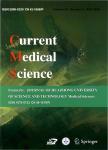Efficacy and Safety of Risedronate Sodium in Treatment of Postmenopausal Osteoporosis
Efficacy and Safety of Risedronate Sodium in Treatment of Postmenopausal Osteoporosis作者机构:Department of Endocrinology Union Hospital Tongji Medical College Huazhong University of Science and Technology Wuhan 430022 China
出 版 物:《Journal of Huazhong University of Science and Technology(Medical Sciences)》 (华中科技大学学报(医学英德文版))
年 卷 期:2005年第25卷第5期
页 面:527-529页
学科分类:1002[医学-临床医学] 100201[医学-内科学(含:心血管病、血液病、呼吸系病、消化系病、内分泌与代谢病、肾病、风湿病、传染病)] 10[医学]
主 题:risedronate sodium postmenopausal osteoporosis bone mineral density
摘 要:Summary: To evaluate the efficacy and safety of risedronate sodium in treatment of postmenopausal osteoporosis, one-year randomized, double blind clinical trial was performed among 54 women with postmenopausal osteoporosis. The changes were compared in bone mineral density (BMD), bone metabolism markers and adverse events after 12 months oral administration of risedronate sodium. BMD was measured by dual energy X-ray absorptionmetry (DEXA) and bone turnover marker was detected. The results showed that there was a significant increase in BMD of the lumbar spine (3.29 %±41.18 %, 4.51%±1.64 % respectively) after 6 and 12 months in the risedronate treatment group versus placebo control group (-0.62 %±0.24 %, 0.48 %±0. 18 % respectively). Bone turnover was decreased to a stable nadir over 6 and 12 months for resorption markers [N-Telopeptide (NTx), P〈0.05] and over 12 months for formation marker (ALP, P〈0.05; BGP, P〈0. 05). The safety profile of risedronate sodium was similar to that of placebo. There were no trends toward increased frequency of any adverse experience except for gastrointestinal symptoms (7.1%), rash (7.1%) and hematuria (3.6 %), which were usually mild, transient, and resolved with continued treatment. It was concluded that risedronate was an efficacious and safe drug in treatment of postmenopausal osteoporosis.



